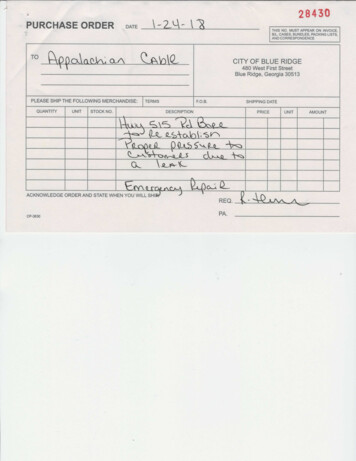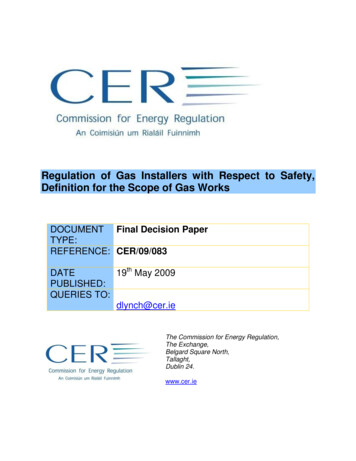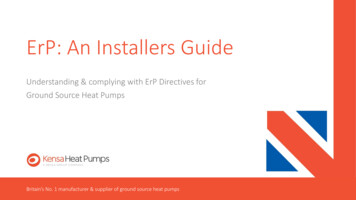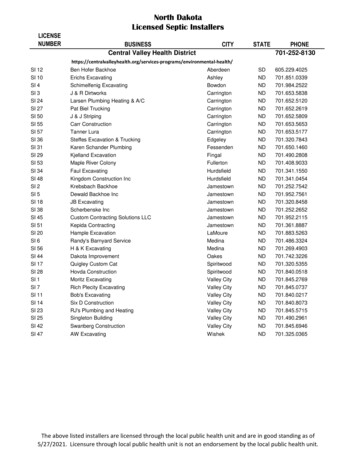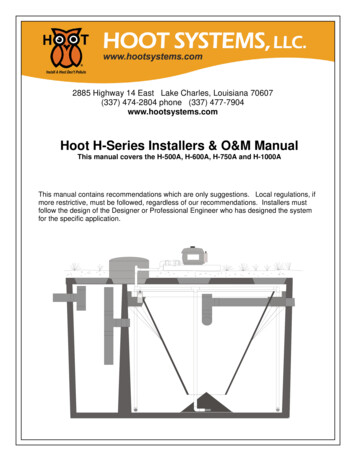
Transcription
2885 Highway 14 East Lake Charles, Louisiana 70607(337) 474-2804 phone (337) 477-7904www.hootsystems.comHoot H-Series Installers & O&M ManualThis manual covers the H-500A, H-600A, H-750A and H-1000AThis manual contains recommendations which are only suggestions. Local regulations, ifmore restrictive, must be followed, regardless of our recommendations. Installers mustfollow the design of the Designer or Professional Engineer who has designed the systemfor the specific application.
Declaration of WarningsWARNING! TO FUNCTION PROPERLY, THE HOOT SYSTEM MUST BE MAINTAINEDBY A QUALIFIED PROFESSIONAL AT LEAST EVERY SIX (6) MONTHS FOR THELIFE OF THE SYSTEM. FAILURE TO MAINTAIN THE HOOT SYSTEM VOIDS THELIMITED WARRANTY AND MAY CAUSE SERIOUS BODILY INJURY OR ILLNESS TOPEOPLE AND PETS AND MAY CAUSE SERIOUS DAMAGE TO THE HOOT SYSTEMOR OTHER PROPERTY.DANGER! ONLY A QUALIFIED PROFESSIONAL SHOULD ATTEMPT TO REPAIR ORFIX THE HOOT SYSTEM. ATTEMPTED REPAIR BY ANYONE OTHER THAN AQUALIFIED PROFESSIONAL MAY CAUSE SERIOUS BODILY INJURY OR DEATH TOTHE HOMEOWNER OR OTHER PERSONS AND MAY CAUSE SERIOUS DAMAGETO THE HOOT SYSTEM AND OTHER PROPERTY.DANGER! DO NOT DISCONNECT THE POWER TO THE HOOT SYSTEM. DISCONNECTION OF THE POWER FROM THE SYSTEM MAY CAUSE SERIOUS ILLNESSOR DEATH TO THE HOMEOWNER AND OTHER PERSONS AND MAY CAUSE SERIOUS DAMAGE TO THE HOOT SYSTEM AND OTHER PROPERTY.WARNING! IN CASE OF IMMINENT FLOOD, IMMEDIATELY TURN OFF THE ELECTRICAL POWER TO THE HOOT SYSTEM AT THE INDEPENDENT BREAKER LOCATED ON THE HOUSE. FAILURE TO TURN OFF THE ELECTRICAL POWER MAYCAUSE SERIOUS INJURY OR DEATH TO THE HOMEOWNER AND OTHER PERSONS AND MAY CAUSE SERIOUS DAMAGE TO THE HOOT SYSTEM AND OTHERPROPERTY.WARNING! IF THE UNIT FAILS TO FUNCTION PROPERLY, DO NOT USE THE BATHROOM FACILITIES UNTIL QUALIFIED PERSONNEL FIX THE PROBLEM. USE OFTHE BATHROOM FACILITIES DURING A SYSTEM FAILURE MAY CAUSE SERIOUSINJURY, ILLNESS, OR DEATH TO PERSONS AND MAY CAUSE SERIOUS DAMAGETO THE HOOT SYSTEM AND OTHER PROPERTY.WARNING! DO NOT ALLOW CHILDREN TO PLAY ON OR AROUND THE AEROBICTREATMENT SYSTEM. ALLOWING CHILDREN TO PLAY IN THESE AREAS MAYCAUSE SERIOUS BODILY INJURY, ILLNESS, OR DEATH TO THE CHILDREN ANDOTHER PERSONS AND MAY CAUSE DAMAGE TO THE HOOT SYSTEM ANDOTHER PROPERTY.DANGER! THE BLOWER AND CONTROLLER CONTAIN NO USER SERVICABLEPARTS. DO NOT OPEN CONTROL PANEL WITHOUT ELECTRICITY DISCONTENTED AND LOCKED OUT ON THE SYSTEM. FAILURE TO DO SO COULD CAUSESEVERE INJURY OR DEATH.1
Recommended Prohibitions in a Hoot Aerobic SystemInert Materials:Plastic, Rubber, Scouring Pads, Dental Floss, Cigarette Filters, Bandages, Hair,Mop Strings, Lint, Rags, Cloth and Towels do not degrade in an on-site treatmentsystem. Inert Materials will build up solids, and lead to system malfunction, clogging or increased pump out frequency.Paper Products:Disposable Diapers, Paper Towels, Baby Wipes, Facial Tissues, Moist Toilet Paperare not designed to dissolve in an on–site treatment system. Excessive Amountsof toilet tissue will also not decompose. All can lead to system malfunction, backup or increased pump out frequency.Food Wastes:Do not put Animal Fats & Bones, Grease, Coffee Grounds, Citrus & Mellon Rinds,Corn Cobs, Egg Shells, down the sink. Garbage disposal use should limited towaste that cannot be scooped out and thrown in the trash. Spoiled Dairy Productsand Yeasts from home Brewery or Baking may cause excessive growth of microbes that do not degrade sewage.Medicinals:Do not flush Baby Wipes, Lotioned or Scented Toilet tissue, Female Sanitary Products, Cotton Balls or Swabs, Condoms or expired Medicines/Antibiotics. SepticTank additives generally do more harm than good. Automatic Disinfection Tablets(blue, clear or otherwise) will kill the organisms needed to consume waste.Chemicals & Toxins:Can kill the microbes necessary for Treatment. Paint, Thinner, Solvents, VolatileSubstances, Drain Cleaners, Automotive Fluids, Fuels, Pesticides, Herbicides, Fertilizers, Metals, Disinfectants, Sanitizers, Bleach, Mop Water, Excessive use ofHousehold chemicals, and Backwash from Water Softener regeneration.Laundry Practices:On-site systems must process the water as it enters the system. Laundry shouldbe spread out over the week, not all run at one time. Excessive use of Detergents,especially those containing bleach, can affect system performance. Liquid detergents are recommended over powders. Fabric Softener sheets are recommendedover liquid softeners. Bleach should be used sparingly and at half the rate indicatedon the container.Clear Water Waste:From A/C Discharge lines, Floor Drains, Gutters, Whole House Water TreatmentSystems and Sump Pumps can increase the flow to your treatment system. Theseflows can at least disrupt, if not destroy your treatment process.2
Table of ContentsDeclaration Of Warnings. Page 1Items to Avoid .Page 2Table of Contents. Page 3HOOT Tank Diagram. Page 4Tank Installation Instructions. Page 5Tank Installation Checklist. Page 6HOOT Trouble Shooting .Page 7HOOT Operation and maintenance . Page 8Stone Flush Instructions. Page 9 & 10Engineering Drawings Section. Page 11H-500 A. Page 12H-600 A. Page 13H-750 A. Page 14H-750 AN .Page 15H-1000 A.Page 16H-1000 AN.Page 17Sample Service Report . Page 183
The HOOT Aerobic Treatment System Diagram11121109582474361. Inlet: Where sewage enters the system2. Pretreatment Tank: Or Trash Trap, for Settling and Floating of non liquid waste.3. Aeration Chamber: Where air is introduced to digest organic waste.4. Clarifier: a still chamber where a clear, odorless, effluent rises.5. Outlet: Where the treated effluent leaves the system.6. Diffuser: How dissolved oxygen is added to the system.7. High Water Alarm: Float that activates the high water alarm.8. Aeration Manifold: How compressed air is delivered to the Diffusers.9. Air Line: Delivers air to the aeration manifold and eventually the diffusers.10. Intergraded Alarm Panel: Provides both High water and compressor failurealarms.11. Linear Air Compressor: Provides the compressed air to operate the system.12. At Grade Access Riser: Provides access to the Pre-Treatment, Aeration andClarifier chambers for servicing and pump out.4
Tank Installation InstructionsTank Installation:1. Soil cover depth: a minimum of 6” inches and no greater than 30”. Systems that need tobe at deeper burial should be serviced through the use of a lift station.2. Prepare an excavation approximately one foot larger than the tank all around with a firm,level bottom. Be sure to check the depth of the excavation to the bottom of the inlet toensure tank will be deep enough for your inlet to flow into the tank.3. Place Tank on a level gravel bed at least 4 inches thick.4. Fill out Hoot Installation and Delivery Tracking Form. Driver should not leave tank at jobsite until this form is filled out.5. Delivery driver will place tank in hole - and confirm it is level within 1 inch from center oftank to any corner.6. Begin filling the tank with water to perform visual water tight integrity test.7. Bring in 4” Schedule 40 Pipe into the inlet end of tank through one or more openings to thePre-Treatment Tank, and Schedule 40 - 4" line out to drainfield.8. Follow local guidance for proper backfilling of remainder of system.9.Bring required access ports to final grade.10. Provide power to hook up the blower/alarm system (20 Amp Service for Gravity, 30 forPumped Effluent System)11. Hook up blower plumbing, 1 ¼” from Blower through grommet into riser.12. Place Blower on concrete pad, Place cover over aerator.13. Power up system - it is ready to accept sewage.14. Fill in Warranty Registration and Service Policy, and give to homeowner.SPECIALINSTRUCTIONS - PLEASE NOTE!The depth of cover is recommended to be a minimum of 6” inches and no greater than 30”.Systems that need to be at deeper burial should be serviced through the use of a lift station Soilused for backfill should be capable of flowing, be watered in or compacted to reduce settling.HOUSE WIRING MUST HAVE 20 AMP (30 AMP FOR PUMPED EFFLEUNT SYSTEMS) INDEPENDENT BREAKER AND MUST MEET NATIONAL - STATE - AND LOCAL REGULATIONS.INSTALLATION AND OPERATION MUST BE IN COMPLIANCE WITH STATE WATER REGULATIONS, COUNTY AND LOCAL PLUMBING AND ELECTRICAL CODES.FAILURE TO COMPLY TO THE INSTRUCTIONS FOR THE INSTALLATION OF THE TANKAND THE SYSTEM CONTROLLER WILL VOID ANY AND ALL WARRANTIES PROVIDED BYHOOT AEROBIC SYSTEMS, INC., AND WILL PLACE THE BURDEN OF WARRANTY COVERAGE ON THE INSTALLER. FAILURE TO FOLLOW INSTALLATION INSTRUCTIONSPROPERLY MAY CAUSE SERIOUS INJURY, ILLNESS, OR DEATH TO PERSONS AND MAYCAUSE SERIOUS DAMAGE TO THE HOOT SYSTEM AND OTHER PROPERTY5
Hoot Installation ChecklistSystem spector:Startup:Model Number (Top Data Plate):Home:Cell:e-mail:Serial Number:Treatment System InstallationLines into System and Out of SystemInlet Pipe into Seal (1/8” Slope), no more than 15 Degrees in any directionOutlet Pipe into Seal (1/8” Slope), no more than 15 Degrees in any direction1 ¼” Airline from Blower to SystemFill and LevelMake Sure Tank is Level within 1” on Top of Aeration Chamber Portion of TankIs Tank Filled with Water (from Front of System to Aeration Chamber)RisersRisers To Grade (or Above)Screws in each hole of each riser (Cannot Seal without them)Lids Screwed Down (All 6 Holes)BlowerBlower Above Finished Grade on PadAir Line & Pressure ConnectedCover (Dog House) over BlowerAngle “Blower Alarm” Towards Home or DrivewayControl PanelMake sure it can be seen under Dog HouseTest Alarm SwitchTest Alarm Float6
HOOT Trouble Shooting SectionProblems at Start Up or After Power LossIf AERATION PROBLEM occurs on Power up - Check Aerobic Chamber. The center tank shouldbe full to the point where the pre-treatment tank is full and water flows into the pump tank. If it isnot filled within 1 foot of the top in the Aeration tank, a AERATION PROBLEM will occur on startup. This occurs because there is not enough back pressure being developed, fill the tank and restart. If there is still a problem, check air line for leaks, black line and compression fittings, checkvalve, and inside tank for a lose or broken diffuser line or blown out/broken stone.Installer Self Test - All systemsThis is a simple test designed to prevent you from needing to return because of a faulty installation As you know, you install the finest product available, to ensure you get off to a good startwith the system owner, go through the following test. Failure to follow these procedures will normally result in a SYSTEM ALARM within the first 12 hours of operation.1. Confirm that the water level in the Aeration (Center) Tank is less than 12" from the lid of thetank.2. Power up - connect power to unit, you will hear a short beep and all the alarm light will come onfor a few seconds. If the system is full with water, then this should stop and normal operationwill occur.3. Check diffuser operation over each of the openings on the aeration chamber. If air is only coming out of one opening, then there is a missing or damaged stone. If no air is coming out, confirm check valve is in the right direction, then listen for air inside tank.4. If enough air is being supplied, and there are no leaks, then you should continue to have operation. If not, and alarm will sound.To Create A High Water Alarm for InspectionTo create a high water alarm for inspection purposes is a simple operation. Make sure system ison. Open the riser when the air line enters and locate the float that come in contact with the airline break. Depress up the air line break. This will release the air and create an aeration alarm.7
System Operation and Maintenance (Every 6 Months)Every 6 months for the lifetime of the system the following need to be tested on each system.Check Blower—The blower must be checked for proper operation, confirm that it is notrunning hot. Remove cover and clean the air filter by knocking off debris, then rise withwater, re-install. If blower is hot, check back pressure. If the back pressure in water column inches is greater than 100, then a Stone Flush is needed to bring the system backinto performance range of :60-70 for 500/600 GPD Systems70-80 for 750 GPD Systems75-90 for 1000 GPD Systems(Items Needed: Pressure gauge that measures in water column inches.)Solids In Aeration Chamber—Take sample using sludge judge from the aeration chamber while the blower is operating. Look at column as you withdraw it form the chamber.There should be a consistent color throughout the column. If it is not, and there are stratifications within the column there is a problem. Deliver the effluent to a graduated cylinderor a clear glass or jar. Let settle for 15 minutes. If the percentage of solids is more than70% after 15 minutes, the tank should be pumped to reduce the potential for solids carryover. (Items Needed: Sludge Judge, Graduated Cylinder or glass jar or bottle)Pump Tank Observation and Maintenance is the most important part of your servicevisit. It can tell you in just a few seconds more information than any other part of thetreatment system.Water Quality and Clarity An observation of the water quality should be made upon arrival to the system. Pay attention to the time of day. Is it first thing in the morning and thepump tank is near the high point in the pump tank? Is there a constant stream of waterinto the system and no one appears to be home? A properly functioning system shouldhave a non-offensive odor, normally described as mustySolids Carry over observe the D-box for solids carry over. Floating debris is an indication of a system that may need to be pumped out, but further testing of the settleable solids level in the aeration chamber is the only way to tell for sure- See Above If the settablesolids level is within an acceptable range (below 70% after 15 minutes) then carry overcan be for a multitude of other reasons, among these are: Surge flows into the system(from garden/Jacuzzi tubs or heavy washing days)8
Stone Flush InstructionsAll Aerobic systems use microorganisms, present in human sewage, to degrade householdwaste. There are two types of systems, Fixed Media, and Suspended Growth. Fixed MediaSystems have surfaces for the bacteria to grow on and the water either flows over or throughthem to break down the sewage. Suspended Growth systems, have the growth suspended inthe tank, and the mixing process keeps it agitated. What none of us in the industry were awareof until recently was that all suspended growth systems start off as fixed media. The growthtakes place on the walls of the tank, the hopper, drop lines, etc until there is so much on thewalls that it can no longer hold on. Once it begins to “sluff off” the sewage acts as an abrasiveand causes it to all go into suspension and clear off of the walls of the tank.Systems that are underused can take a long time to develop enough flock to go into suspension. Also, systems with little to no use, can grow algae, that will grow into its only availablefood source, the oxygen being provided by the aerator. This problem is worsened by high water temperatures. Systems with little or no cover will be more susceptible to the heat.The Dead Head alarm goes off on our system when the pressure reaches 160 Water ColumnInches in the tank. This indicates an air flow into the system so compromised that the systemwill fail to treat the sewage and turn septic. A properly functioning system should run between56 and 65 for a 500 GPD system and 70 and 80 for a 1000 GPD. To read out the air pressure,put the system into the 3rd Beep mode (described in the Flash Codes Handout.) To enter thismode, restart the controller by depressing the Silence Alarm button for 16 seconds, release after the double beep and press again. Continue to hold and you will hear a single beep, followed 8 seconds later by one chirp, then two chirps, then three chirps release the switch. Thecontroller will turn on the aeration problem lamp to indicate the air pressure test mode andchirp/flash the air pressure in inches of water. For example 65in/water 6 chirps pause 5 chirpslong pause repeat. A zero is indicated by a beep instead of a chirp. For example 102in/water 1chirp pause 1 beep pause 2 chirps long pause repeat. Ignore the first reading, it is inaccurate.If the pressure exceeds 100, then it is recommended to clean the stones to reduce the backpressure to the system. It will be necessary to use a Water Column Inch gauge if this is an oldstyle controller.In the past, the only way to reduce the pressure on the system was to change out the stones onthe system. We have developed a method of cleaning the stones out, that is as effective asreplacing the stones, and can be done from the top of the tank. The entire procedure will takeless than 10 minutes and can be done during a regular scheduled service visit, particularly inthe spring (before the hot weather) on under used systems.You need to make a solution that will cleanse all of the stones, so it is necessary to pour a largevolume of solution down the aeration tubing all at once. A solution can be made in a five gallonbucket. Add 2 oz. of pH down or pH minus to 4 gallons of water. Always add the powder to thewater, not water to the powder and mix.To flush the stones it will be necessary to remove the check valve from the blower air assembleas pictured to the right. If you have a remotely mounted the system, it will be necessary to getnext to the tank and cut the line right before it goes into the system. This procedure will notwork if you are filling more than 4 feet of pipe outside the tank.9
Slide on the funnel attachment pictured to the right. It can be made using a 1 1/4" 90, 1foot of 1/14" pipe a 4" to 2" Reducer bushing and a 2" to 1 1/4" bushing. Pour the entirecontents of the 5 gallon bucket into the funnel. When the funnel fills, wait for the level to godown, and fill again.Prop up underneath the 90 so a trapformed is not formed. Another piece ofpipe, or a shim of some type will do thetrick. Empty the entire bucket into the system. Once it has completely drained intothe system, re-install the check valve andpower up the system, putting it into the 3rdmode - Aeration Pressure. The pressure should drop almost immediately tothe 60 to 80 inch range.Once it reaches that level, again disconnect the check valve, allowing the pipeto aging fill with water, and then reconnect the check valve and power up.This will move out any additional remaining solution.Always use caution when using chemicals of any type. Use Caution to prevent contactwith skin and clothing. Eye Protection and Gloves must be used when handling the chemicals or the solution. Do not mix with any other chemicals or solutions.hth pH Minus is available at Wal-Mart and pool supply stores. pH Down is available atHome Depot. The product should contain at least a Sodium Bisulfate content of 90%.10
2885 Highway 14 East Lake Charles, Louisiana 70607(337) 474-2804 phone (337) 477-7904www.hootsystems.comHoot H-Series Engineered DrawingsThis manual covers the H-500A, H-600A, H-750A, H-750AN, H-1000A and H-1000ANEvery attempt to make the following drawings to scale has been made, however somecomponents may have been exaggerated to show additional detail. Local regulations, ifmore restrictive, must be followed, regardless of our recommendations. The Designer orProfessional Engineer must follow any local rules when designing a system.
Hoot H-Series Service and Inspection FormThis testing and reporting shall be completed, signed and dated after each inspection. Onecopy shall be retained by the maintenance company. The second copy is sent to the localpermitting authority and the third copy is sent to the system owner along with an invoice forservices by the maintenance company.1.2.Actual Date of Visit:System Inspection ofOwner:Address:City, St., Zip:Inspected Items:OperationalInoperativeNot ApplicableAerator.Aeration Plumbing.Air Filter.Effluent Pump (if applicable).OK System Light.Alarm Operation.D-Box .Air Filter must be cleaned each service visit. Operation of effluent disposal system must be madeeach visit (if pumped effluent system). A system with greater than 70% Settleable Solids in theaeration chamber must be pumped to avoid solids leaving the tank for the drainfield.3.Repairs to system (list all components replaced):4.Tests Required and Results:TestBOD (Grab)TSS (Grab)pH (Grab)RequiredResultsTest Method5.Comments:Signature of Inspector: Operator License #18
For Additional Information, Please Contact:HOOT Aerobic Systems, Inc.2885 Highway 14 East Lake Charles, LA 70607(337) 474-2804 phone (337) 477-7904 faxwww.hootsystems.comPrinted in U.S.A.Rev.1 GF-HOOT 9/09 HOOT Aerobic Systems, Inc. 2009
to function properly, the hoot system must be maintained by a qualified professional at least every six (6) months for the life of the system. failure to maintain the hoot system voids the limited warranty and may cause serious bodily injury or illness to people and pets and may cause serious damage to the hoot system or other property. danger!



